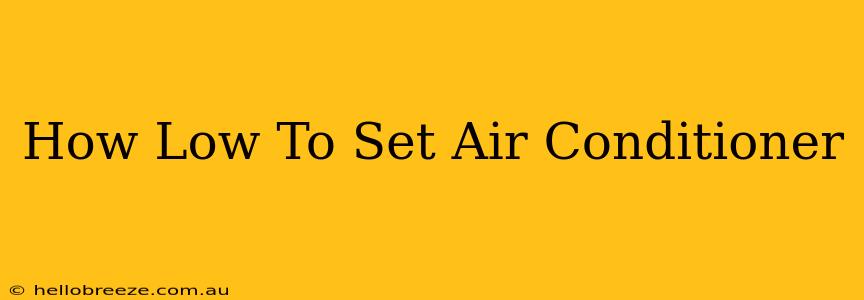How Low Should You Set Your Air Conditioner? Finding the Sweet Spot Between Comfort and Energy Savings
Summer's heat can be relentless, making the air conditioner a lifeline. But how low should you really set that thermostat? The answer isn't a simple number; it's a balance between comfort and keeping your energy bills manageable. This guide will help you find the perfect temperature for your home, minimizing energy waste without sacrificing comfort.
The Ideal Air Conditioner Temperature: It's Not About the Lowest Setting
Many believe cranking the AC to its lowest setting provides the quickest cool-down. This is a misconception. While it might feel instantly cooler, it's actually incredibly inefficient and costly. Your AC unit works harder, consuming more energy and potentially shortening its lifespan. Plus, extremely cold temperatures can lead to discomfort, such as chills and muscle aches.
Instead of aiming for the lowest possible temperature, focus on achieving a comfortable and energy-efficient setting. A good starting point is 78°F (26°C) when you're home and awake. This is the temperature often recommended by energy experts. You can adjust this based on personal preference, but remember, every degree lower significantly increases energy consumption.
Factors Influencing Your Ideal AC Temperature
Several factors influence the ideal temperature for your home:
- Personal Preference: Some people prefer cooler temperatures than others. Experiment to find what feels comfortable without shivering.
- Activity Level: If you're engaging in strenuous activities at home, you might prefer a slightly lower temperature.
- Health Conditions: Certain health conditions may necessitate a slightly cooler or warmer environment. Consult your doctor if you have concerns.
- Home Insulation: A well-insulated home retains cool air more efficiently, allowing you to set your thermostat higher without sacrificing comfort. Poor insulation will require a lower setting to maintain the same level of coolness.
- Humidity: High humidity makes it feel hotter than the actual temperature. A dehumidifier can significantly improve comfort, allowing you to increase your thermostat setting.
Smart Ways to Save Energy While Staying Cool
Besides setting your thermostat wisely, consider these energy-saving tips:
- Programmable Thermostat: Use a programmable thermostat to automatically adjust temperatures when you're away or asleep.
- Regular Maintenance: Schedule regular AC maintenance to ensure optimal efficiency. Clean filters regularly and have a professional check for leaks and other issues.
- Seal Air Leaks: Caulk and weatherstrip windows and doors to prevent cool air from escaping.
- Use Fans: Ceiling fans or portable fans can help circulate cool air, allowing you to raise the thermostat setting.
- Close Curtains and Blinds: Keep direct sunlight out during the hottest parts of the day.
- Cook Smart: Avoid using the oven or stove during peak heat hours to reduce heat buildup in your home.
Finding the Perfect Balance: It's About Comfort and Efficiency
Ultimately, the "how low" question depends on your personal comfort level and energy efficiency goals. Start with 78°F (26°C) as a baseline, and adjust according to your needs and the factors discussed above. Remember that small changes can make a big difference in your energy bill and overall comfort. By implementing energy-saving strategies and making smart choices, you can enjoy a cool and comfortable home without breaking the bank.

